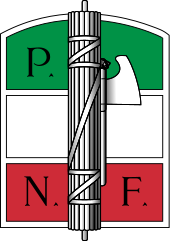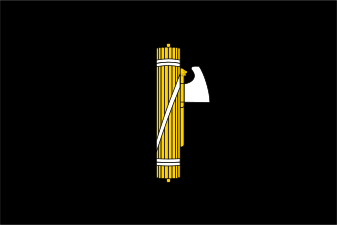Partito Nazionale Fascista
| Partito Nazionale Fascista National Fascist Party |
|
|---|---|
| Party leader | Benito Mussolini |
| founding | November 9, 1921 |
| Headquarters | Palazzo del Littorio , Rome |
| Youth organization | 1921–1926: Avanguardia Giovanile Fascista (AGF) 1926–1937: Opera Nazionale Balilla (ONB) 1937–1943: Gioventù italiana del littorio (GIL) |
| newspaper | Il Popolo d'Italia |
| Alignment | Italian fascism |
| Colours) | black |
| Number of members | 2.4 million (1942) |
The Partito Nazionale Fascista ( PNF for short , German National Fascist Party or National-Fascist Party ) was the party of the Italian fascists from 1921 to 1943 . It emerged from the Fasci di combattimento founded by Benito Mussolini in 1919 . From 1922 the PNF was involved in the Italian government with Mussolini as prime minister and from 1926 to 1943 it was the dictatorial state party of fascist Italy .
history
The fascist movement existed before the party's founding, especially from the paramilitary Fasci di combattimento . When the party was founded in Rome on November 9, 1921 , it was transformed into a comprehensive political association. The main task of the PNF was initially to take away the fear of fascist momentum from the Italian bourgeoisie and thus to offer them fascism as an attractive opportunity to combat a perceived socialist danger .
During the march on Rome of the fascists, Mussolini was able to use the combination of a political party and a militant mass movement as an effective leverage to gain power. Mussolini became Prime Minister on October 29, 1922, even before the actual march on Rome began, which only took place two days later. After massive changes to the electoral laws through the so-called “ Acerbo Law ”, the PNF clearly won the extremely controversial elections of April 1924. From 1928 the PNF was the only legal party in Italy, which did not change until 1943. After Mussolini's arrest and his dismissal from the Grand Fascist Council initiated by Dino Grandi , the party was dissolved on July 24, 1943 and officially banned by the Pietro Badoglio government on July 27 .
After the liberation of Mussolini (" company oak ") in September 1943, the German Reich established a puppet state in the areas of northern Italy occupied by the Wehrmacht , the Italian Social Republic ("Republic of Salò"), in which the party then became republican on September 13th Fascist Party ( Partito Fascista Repubblicano , PFR) was revived. The party leader was Alessandro Pavolini , head of state and government Benito Mussolini. With the murder of Mussolini by the Resistance and the dissolution of the Republic of Salò, the PFR also disappeared in April 1945.
symbolism
Secretaries of the National Fascist Party
- Michele Bianchi (November 1921 to January 1923)
- Triumvirate : Michele Bianchi, Nicola Sansanelli, Giuseppe Bastianini (January 1923 to October 1923)
- Francesco Giunta (October 15, 1923 to April 22, 1924)
- Quattuorvirate : Roberto Forges Davanzati, Cesare Rossi, Giovanni Marinelli, Alessandro Melchiorri (April 23, 1924 to February 15, 1925)
- Roberto Farinacci (February 15, 1925 to March 30, 1926)
- Augusto Turati (March 30, 1926 to October 7, 1930)
- Giovanni Giuriati (October 1930 to December 1931)
- Achille Starace (December 1931 to October 31, 1939)
- Ettore Muti (October 31, 1939 to October 30, 1940)
- Adelchi Serena (October 30, 1940 to December 26, 1941)
- Aldo Vidussoni (December 26, 1941 to April 19, 1943)
- Carlo Scorza (April 19, 1943 to July 25, 1943)
literature
- Richard JB Bosworth: Mussolini's Italy. Life under the Fascist Dictatorship, 1915-1945 . Penguin Books, New York NY et al. 2007, ISBN 978-0-14-303856-6 .



